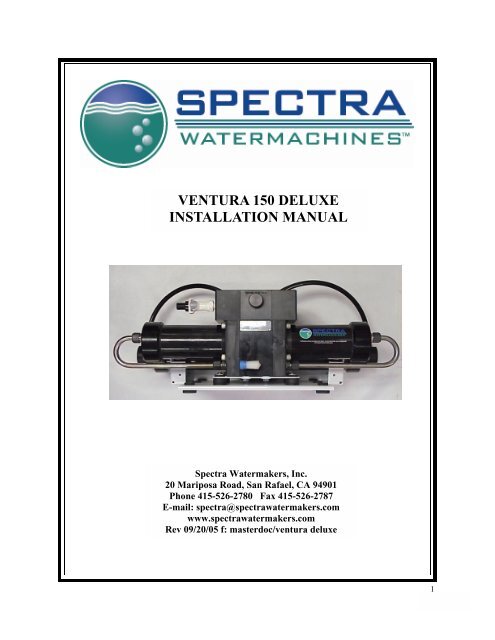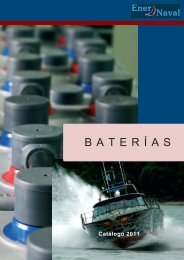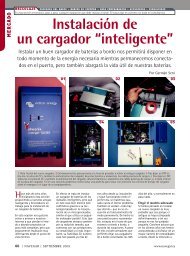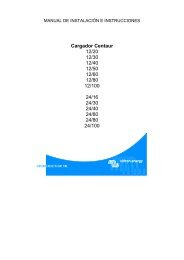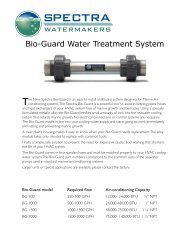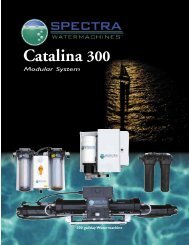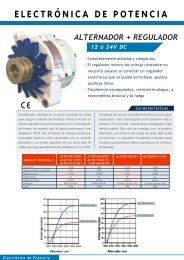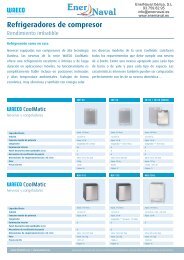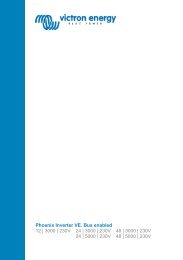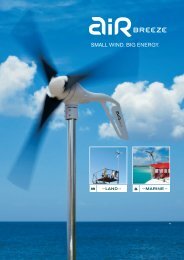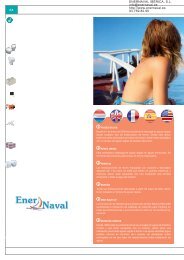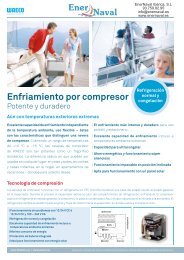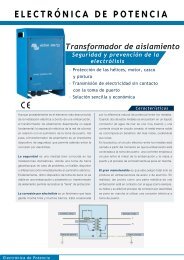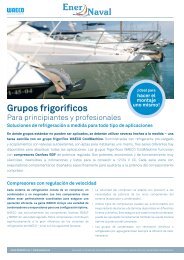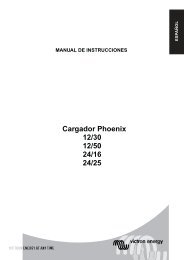VENTURA 150 DELUXE INSTALLATION MANUAL
VENTURA 150 DELUXE INSTALLATION MANUAL
VENTURA 150 DELUXE INSTALLATION MANUAL
You also want an ePaper? Increase the reach of your titles
YUMPU automatically turns print PDFs into web optimized ePapers that Google loves.
<strong>VENTURA</strong> <strong>150</strong> <strong>DELUXE</strong><strong>INSTALLATION</strong> <strong>MANUAL</strong>Spectra Watermakers, Inc.20 Mariposa Road, San Rafael, CA 94901Phone 415-526-2780 Fax 415-526-2787E-mail: spectra@spectrawatermakers.comwww.spectrawatermakers.comRev 09/20/05 f: masterdoc/ventura deluxe1
Table of ContentsInstallationPage NumberGetting Started .....................................................................................................................5Introduction..........................................................................................................................6Salt Side Piping Schematic ..................................................................................................7Product Piping Schematic....................................................................................................81/4 Inch tube Fitting Instructions.........................................................................................9Membrane Housing Relocation .........................................................................................10Wiring Diagram .................................................................................................................12Feed Pump Relocation .......................................................................................................13Z Brane Installation ...........................................................................................................33OperationNew Systems Start Up and Testing ...................................................................................14Dry Testing ........................................................................................................................15Normal Operation .............................................................................................................16Maintenance.......................................................................................................................20Service & MaintenanceLong Term Storage Procedures .........................................................................................17Winterizing ........................................................................................................................19Membrane Cleaning...........................................................................................................21Suggested Spares ...............................................................................................................23Catalina Troubleshooting Procedures, Service Bulletins...................................................24Parts breakdown for VT-<strong>150</strong> Deluxe systems ...................................................................363
Getting StartedUnpack the system and inspect it to make sure that it has not been damaged in shipment.Refer to the shipping list for your system to make sure you have received all of the componentslisted. Do not discard any packaging until you have found and identified all of theparts. The small installation parts are listed on the kit list.Warning! We will not be held responsible for shortages and or freight damage that are notreported within thirty days of the ship date.Study the system layout diagram, component photos and descriptions before beginning yourinstallation. This will assist you in understanding the function of each component.Layout the system. Before starting the installation identify the location where each moduleand component will be placed. Insure that there is proper clearance around the componentsfor removal of filters and system service. Also check to make sure you have adequate tubingand hose before starting so additional parts may be ordered.Ventura Deluxe Shipping List• High Pressure Clark Pump and Reverse Osmosis Membrane Module.• Feed pump inlet module with fresh water flush system.• Accumulator Tank• Seawater strainer• Monitor Gauge panel• Installation Fittings Kit• Service Hose kit• Hand held Salinity monitor• 5/8” Hose (50’)• 1/4 product tubing (25’)5
Introduction to the Ventura <strong>150</strong> DeluxeThe Ventura represents the finest watermaker for small and midsized yachts available today.The Spectra Clark Pump is matched to a 21” high rejection membrane. Properly installed andmaintained it will supply years of reliable service. Prudent operational is required with anymarine equipment. Always maintain enough reserve water to get safely into your next port.The Spectra Intensifier, known as the ClarkPump, was introduced in 1997 and has continuallyimproved since. It holds a lifetime warrantyfor the original purchaser! It is built of modernnon-corrosive composites.Quick disconnect fitting tofacilitate maintenance.Front ViewPressure relief valveDouble rubber mountsfor to absorb vibrationRear ViewThe Clark Pump Membrane Module. Premountedand plumbed together as a singleunit. Saves time and adds reliability.Ventura feed pump inlet module.Includes the feed pump, cooling fan, charcoal filter for theflushing system, manual flush valve, service valve and serviceport . Compact and streamlined plumbing. Feed pumpmay be removed and relocated if necessary. Cooling fan isincluded for long life.6
Ventura <strong>150</strong> Deluxe PlumbingBrine Discharge thru hull placeabove waterline or tee brine intoanother visible drain.PressureRelief ValveSpectra Clark Pump. Mount in a cool location. May beoriented in any position and can be well above waterline.Leave access to the pressure relief valve. Do not mountover electrical equipment. Use supplied spacers and washersfor the vibration mounts.Plastic fittings should have 3-4 wraps of Teflontape and will thread almost all the way in. Leavethe first pipe thread uncoated. Avoid getting dirtor debris in the system during assembly. Avoidtight bends and elbows. Secure piping away frommoving objects and protect from chafe.Fresh water flush inlet to charcoal filter.Plumb to fresh water system.5 micron filter. Donot mount overelectrical equipment.Leave clearance belowfor filter change.Accumulator, Factory pre-charged.Install and plumb as shown.Sea Strainer, Mount withQuick BlockInlet pump module. Mount vertically aslow as practical, no more than 4’ (1.1 M)above waterline and not over electricalequipment.Leave clearance below for filter change.1/2” or 3/4 scoop strainer thru hull and seacock for water maker only. Mount low, ina clear flow and away from head discharge. Thru hull is shipyard supplied.Bow of VesselWater Flow7
Product Water and Pressure Gauge Tube InstallationSampling Tap for testing the productwater or for service procedures.Put enough tube on this port to reachyour service (pickling) container.Route the product water from the valveinto the top of the tank. Install a tee inthe water fill or tap a pipe thread intoan inspection port.Product to tank.DO NOT! feed the product into a ventline, manifold or the bottom of the tank.Make sure that there is no restriction inthis piping. Pressure in the producttubing must never exceed 5psi (.3bar)at any time, (running or stopped) or themembrane will be permanently damaged.Product sampling valve. Mount using the suppliedplastic straps as shown.Note: the handle is pointing in the direction of theflow.Use accumulator port to connect the pressuregauge. Use the supplied 1/4” black nylon tubing.If other tubing is used it must be pressurerated to <strong>150</strong> PSI (10 BAR)Pressure GaugeProduct Flow meterPlastic fittings should have 3-4 wraps of Teflon tape andwill thread almost all the way in. Leave the first pipe threaduncoated. Avoid getting dirt or debris in the system duringassembly. Secure piping away from moving objects andprotect from chafe. Exercise care not to cross thread thefittings. See the tube assembly instructions next page.Back view of instrument panel.Use the supplied 1/4”black nylon tubing forthe product plumbingProduct Ports arelocated hereRemove one of the product port plugs (from either end) andthread in the product fitting with Teflon tape sealant.Product fitting8
BodyO-ringSpacerGrab RingNutTubingStep 1:Dissemble fitting components1/2" maxStep 2:Install the Nut first then use the bevelled side of the Spacer to push theGrab Ring onto the tube no more than 1/2". Slip the O-ring over the tubeto hold the Spacer in place. If the Grab Ring is pushed too far, trim backthe tube so about 1/4" of tube extends past the O-ring.Step 3:Gently fit the tube into the body and loosely thread on the nut.Step 4:Push the tube into the body until it bottoms out then hand tighten the nut.DO NOT OVER TIGHTEN!1/4" Tube Fitting Assembly9
Membrane Pressure Vessel RelocationUse ONLY Dayco Imperial Nylo-Seal 88-NSR-1/2 tubing for high pressure connections.Pay attention to the direction and flow path of the tubing before disassembly. Make surethat you reinstall the tubing in the same manner. Rotate the 90 degree high pressure tubefittings on the Clark Pump for ideal tube runs. The high pressure fittings are typically preinstalledat the factory. These fittings seal with an O-ring and require no Teflon tape or pipedope. Loosen the backing nut, rotate the fitting, and reseat the backing nut.Follow the high pressure tube connection instructions on the next page. Connect thetubes to one of the components, secure the tube runs, and then trim and connect to the othercomponent. A 90 degree bend in a tube is better than a 90 degree fitting. A tube, whenmounted, should have at least one gentle bend to allow for expansion. Do not connect atube straight between hard mounted fittings.When connecting the tubes to their components, be sure to hold the fitting body with awrench during the final tightening. Of special note are the stainless steel tube fittings on themembrane housing which seal on an O-ring and should be seated all the way in. Hold thefitting with a wrench while installing the tube.The fittings on the Clark Pump have an O-ring seal and can be reoriented by backing outthe O-ring stop nut. Rotate the fitting to align with the tube and tighten the nut just pasthand tight. DO NOT over tighten!10
Spectra High Pressure Tube Fitting AssemblyUse ONLY Dayco Imperial Nylo-Seal 88-NSR-1/2 tubing for high pressure connections.Carefully fit and measure the tubing before cutting with a sharp razor knife or hose cutter and removeany burrs. Minimum tubing bend radius is 6”. Route tubing away from excessive heat sources andsecure from vibration and chafe. Have at least one shallow bend in the tube assembly after it is installed.Refer to figure 1. If a fitting has been dissembled, reassemble as illustrated. The notch on the ferrulemust engage the inside of the nut properly for the nut to seat down fully. Once the tube is inserted theferrule and nut will naturally align.Refer to figure 2. Insert tube fully into the fitting; it should go in 0.9”. Tighten the nut finger tight whilemoving the tube around to prevent binding. One thread should be showing under the nut. Secure the tubeso it won’t back out when tightening.Refer to figure 3. Use 13/16” wrench to hold a straight body fitting or a 3/4” wrench for a 90º body, anda 7/8” wrench for the nut. Hold the body, recheck the tube insertion, then tighten the nut 1-1/4 turns. Usethe index mark on the nut as a guide. The threads should be completely covered by the nut.Make sure these fittings are tight on initial assembly or they will fail!The correct torque specification is 85 foot poundsIndex markStraight threadStraight or 90 deg.3/8" pipe threadFigure 1.NutCut tube squareFerruleBodyNut finger tight with1 thread showingFigure 2.Black high pressure tubingTighten 1-2/3 turns (10 flats of thenut) with a7/8" wrench after finger tight.Use index mark as guideNo threads showingFigure 3.Insert tube 0.9" until it stopsIMPORTANT!Hold fitting body with 13/16"wrench when tightening11
Ventura <strong>150</strong> Wiring DiagramRoute a heavy pair of wires from the main DC electrical panel to the Feed Pump location.Splice with butt connectors or a terminal block. Seal connectors. A switch located near the feedpump will facilitate maintenance. Voltage drop will impair performance of the system. Wirelength is the sum of the Positive and Negative wires.Wire Size Guide for Ventura <strong>150</strong> 12VProtect with 15 Amp Fuse or Circuit Breaker# 10 Gauge (6mm) to 15 feet (4.5M)# 8 Gauge (10 mm) to 25 feet (7.5M)#6 Gauge (16mm) to 35 feet (10.6M)Wire Size Guide for the Ventura <strong>150</strong> 24VProtect with 7 Amp Fuse or Circuit Breaker#12 Gauge(4mm) to 10 feet (3M)#10 Gauge (6mm) to 25 feet (7.6M)#8 Gauge (10mm) to 35 feet (10.6M)Feed Pump wiring, Red is PositiveBlack is Ground.Main DC Electrical PanelCooling Fan Connects in parallel with the Feedpump. Same color code.DC negative buss barTo Battery12
Feed Pump RelocationIf you do not have adequate space to install the feed pump inlet module it is possible to removeand relocate the feed pump. Before you install the module, disconnect the hose thatconnects the feed pump to the module plumbing. Remove the cooling fan and the heat sinkfrom the pump. Both are friction fits with no fasteners. Remove the 4 machine screws holdingthe pump to the module.Cooling fanHeat sinkMachine ScrewsWith the pump on a flat surface. Remove the threescrews that hold the pump head on. See Fig1Re-orient the pump head 120 degrees. See Fig2Reinstall the screws and tighten firmly. See Fig3Fig 1Now the feed pump may be installed where you wish.Do not install the pump with the head above the motorin case of leaks.Fig 2 Fig 313
Ventura Deluxe New System Start-Up and TestingAvoid running the Ventura system if the vessel is in contaminated water, such as in a pollutedharbor or canal. The system should be fully run tested before leaving on your cruise.If the location or weather prevents proper testing refer to the section “Dry Testing.”Warning! Damage may occur if the purge sequence is bypassed and the membrane ispressurized with storage chemical in it.1. First check that:• Thru-hull inlet valve is open and the brine discharge valve is open.• All of your hose connections are tight.• The “WARNING” tag and spacer from under the pressure relief valve has beenremoved.• The pressure relief valve is open 1/2 turn.• The sampling valve is set to the sample position.Remove Tag and Washer!Open 1/2 Turn to Purge Chemicals!2. Turn on the feed water pump. Check that it is primed by inspecting the brine discharge.About 1.5 gpm (6 lpm) of water should be going overboard with a pulsation every few seconds.3. Run the system without pressure for 20 minutes to purge the storage chemicals. The systemshould have an open flow pressure on the gauge of about 20 PSI (1.2 bar).4. Close the pressure relief valve. The pressure should rise to 60-80 PSI (4.2-5.7 bar). Afterseveral minutes, water should begin to flow out of the sampling tube. If the vessel is locatedin brackish or fresh water the pressure will be lower.5. Allow the system to run for 5-10 minutes and then test the product with your hand held salinitytester. When the product is below 750 PPM it is considered potable and may be divertedto the tank.14
Ventura Deluxe Dry Testing With Artificial OceanIf it is not possible to test run the system with the boat in the water, testing may be accomplished withan artificial ocean. Purchase enough aquarium salt to make 5 gallons (20 liters) of salt water.Make sure that the domestic water system is powered up and that there is at least 30 gallons (120 Liters)of water in the tank. Confirm that the charcoal filter is installed in the fresh water flush moduleand that the domestic water line had been installed and all valves are open.1. Open Pressure Relief Valve on the Clark Pump. Remove the green tag and spacer!2. Close the yellow service valve on the inlet module. This will be the center location.3. Open the grey fresh water flush valve.4. Start the feed pump and let it run 20 minutes to purge the storage chemical overboard.5. Stop the feed pump6. Hook up your inlet and brine discharge service hoses per the photo and route them into the 5 gallon(20 Liter) container. Turn your product sample valve to the sample position. Route the productoutput into the bucket.7. Restart the feed pump and fill the bucket with fresh water from the brine discharge. Stop thepump and close the fresh water flush valve.8. Rotate the yellow service valve to the service position.9. Mix the salt to the proper proportion or use an aquarium hydrometer to adjust the salinity level.10. Start the feed pump, allow to prime and then close the pressure relief valve. The system shouldbuild pressure and after several minutes start making water.11. Run the system under pressure and check for proper operation and leaks.After testing the system stop the feed pump and replace the brine discharge hose. Restart and drainthe bucket. You can now store the system by using the above procedure for adding fresh water to thebucket and using the storage procedure. If the system is to continue to be commissioned performing,a fresh water flush will hold the system for 4-5 days.Valves in flush positionValves in service positionInlet service hose connected.Connecting the BrineDischarge service hose.15
Ventura Deluxe OperationNormal operationIf the system has been pickled or stored or contains cleaning compounds, use the “NewSystem Startup” procedure.1. Check to see that the inlet seacock is open.2. Turn the product valve to the “Sample” position.3. Start the feed pump and check for flow by inspecting the brine discharge or checking forpressure on your analog gauge. If there is no flow open the pressure relief valve on theClark Pump and bleed the air out of the feed pump.4. Check the product water with your hand held salinity tester. When it is below 750 ppm,you may divert it into your tank.5. Run the system until you have filled your tank or have made enough to meet your requirementsfor several days.6. Turn on the fresh water flush valve and close the service valve.7. Flush for 2 1 / 2 minutes or until the pressure drops on the gauge indicating that the membraneis flooded with fresh water. Stop the feed pump.8. Return the service valve and the flush valve to their run positions.You may now leave the system unattended for up to five days without further attentionWe recommend operating the system for longer periods and effecting a fresh water flushrather than running the machine every day and not flushing the system. Remember that youneed to run the system almost a half an hour to make the flushing water. You may notice thatthe system output is higher while charging your batteries as the machine is voltage sensitive.Inlet Module with valves in thenormal “Run” Position.Inlet Module with valves in the“flush” Position.ClosedOpenOpenClosed16
Long Term Storage ProceduresWatermakers are best run continuously. When not in use, biological growth in the membraneis the leading cause of membrane fouling. A warm environment will cause moregrowth than a cold environment. The fresh water flush system will greatly reduce biologicalgrowth but may not stop it completely in certain conditions. If an optional “Zeta Guard”or Z-Brane water treatment system is installed in the system, then three to five day flushingintervals will maintain the system as long as fresh water is provided and the charcoal filtermaintained.System Storage or “Pickling”If the system is to be left unused for more than five days, perform the following storage procedure.The procedure introduces a chemical compound into the system that prevents biologicalgrowth. This procedure requires de-chlorinated water which can be made with thecharcoal filter. Charcoal filters last a maximum of 6 months once wetted.Spectra SC-1 a special storage compound used by the US Navy. It is formulated to becompatible with the modern engineering plastics and composites in the Spectra pumps.Do not use any substitute except propylene glycol. If you wish to use glycol for storage,follow the winterizing instructions. SC-1 Storage Compound has to be mixed at a ratioof 1 container to 3 gallons (12L) of fresh water to have the proper solution for shortterm storage (under two months use 1 / 2 of a container)Caution! Avoid contact with skin, eyes, or lungs with the storage chemical.17
Ventura Deluxe Storage Procedure1. Perform a fresh water flush as described in the normal operation section. Shut down thefeed pump but leave the valves in the flush position.2. Remove the quick disconnect fitting from the brine discharge outlet of the Clark Pump andreplace with a quick disconnect service hose from your service kit. Lead the hose to a 5 gallonbucket or container.3. Start and run the feed pump until you have one gallon of fresh water in the bucket.4. Mix 1 container of SC-1 storage compound with the water in the bucket.5. Connect the service hose, using the garden hose barb fitting from your service kit, to theservice port of the fresh water flush module. Lead the hose into the bucket. Turn the servicevalve on the fresh water flush module 180°, so the intake is now coming from the bucket.6. Make sure the pressure relief valve on theClark Pump is OPEN (unpressurized)by turning 1 / 2 turn counterclockwise7. Turn on the feed pump. Circulate the storagechemical in the system for approximately 10minutes. Turn off the feed pump when finished.Clean UpRemove the quick disconnect from the Clark Pump brine discharge, and replace the originalhose that leads to the thru-hull. You may at this point, if you choose to, pump the bucket dryby using the feed pump switch. Stop when the bucket is empty.Turn the service valve 180° back to its original position, and remove the service hose.Close the seacock and drain and clean the strainer and any filters in the system. Reassembledry.18
Pickling and Winterizing with AntifreezeThe watermaker can be stored for periods up to one year in any climate using this procedure.1. Close the yellow service valve, open the Grey flush valve, and run the feed pump 4 minutesto effect a complete fresh water flush. Shut the pump and flush valve off.2. Connect the inlet service hose and put it in the service container or bucket.3. Turn the service valve to the service position.4. Pour 2 gallon (8L) of propylene glycol in the bucket.5. Make sure that the pressure relief valve is OPEN (un-pressurized).6. Turn on the feed pump until antifreeze begins to show at the brine overboard fitting, thenstop the pump. Add more antifreeze if necessary.7. Connect the brine discharge service hose and place it in the bucket.8. Circulate the antifreeze for about five minutes.9. Stop the pump. Reconnect the brine discharge hose. Restart the pump until the bucket isempty.10. Close the seawater intake and the service valve. Drain the strainer and the hose leading tothe inlet module. Disconnect the product tubing and blow any residual water out of the tubingwith compressed air. Empty the charcoal filter housing and flush water lines.Valves in flush positionOpen the pressure relief valveValves in service positionConnecting brine discharge hose19
GeneralMaintenancePeriodically inspect the entire system for leakage and chafe on the tubing and hoses. Repairany leaks you find as soon as practical. Some crystal formation around the Clark Pump blocksis normal. Wipe down any salt encrusted areas with a damp cloth.The Seawater StrainerThe sea water strainer’s stainless steel element should be inspected, removed, and cleaned asneeded. Be careful to ensure that the thru-hull is closed before disassembly and the gasket is inplace before reassembly. When the system is put into storage, remove, rinse, and reassembledry to impede corrosion. Check frequently during operation.The Prefilter• Service the prefilter on a regular basis. The pressure will rise on the remote gauge when thefilter becomes dirty. Extremely dirty filters will harm system performance and may causethe feed pump to cycle on the high pressure switch. Do not leave dirty filters in the machineduring long idle periods, as biological contamination could result.• To service the filters, shut off the service valve, open the housing, and discard the old filter.Clean out the housing bowl, reassemble the housing with a new 5 micron filter element.Leave dry until next startup.• Use only Spectra approved filters or you may void your warranty. The filters may becleaned several times with a soft brush and water in a bucket. Occasionally, lightly lube thefilter housing O-ring with silicone grease.Oil Water Separator (Optional)To install oil water separator capability install the additional filter housing with its oil removalfilter upstream of the 5 micron filter. Service at the same time as the 5 micron filter.The Charcoal Fresh Water Flush Filter• Replace the charcoal filter element at least every 6 months! This filter protects the membraneby removing chlorine from the fresh flush water. Use only a Spectra replacement!The Feed Pump and Clark PumpThe feed water pump and the Clark Pump require no routine maintenance except inspection forleaks. Tighten any hose clamps or fittings the show signs of leakage. The high pressure fittingsthreaded into the Clark Pump have O-ring seals with a straight thread. These should never leakand should never be over tightened. If one of the tube nuts starts to leak, it can be un-threaded,sealed with a bit of silicone grease or silicone sea, and tightened with two wrenches verytightly.20
The Membranes• The membranes need to be cleaned only when feed pressure begins to rise due to fouling orthe product quality degrades. The leading cause of fouling is from biological growth thatoccurs when the system is left unused without flushing or pickling. Fouling from mineralscaling can happen during operation under certain sea water conditions, and from rust.Monitor the product salinity and feed pressure for higher than normal readings for the existingconditions. Other conditions can cause high pressure such as cold feed water or cloggedfilters. Low product flow is usually due to low voltage, damaged feed pump or Clark Pump.Look for all other causes before cleaning the membrane. Membrane life can be shortened byexcessive cleaning.• There are two types of cleaners: acid and alkaline. The acid cleaner (SC-3) will remove mineralscaling. The alkaline cleaner (SC-2) is used to remove biological by-products, oil, anddirt particles that get past the prefilters. If membrane performance is reduced and they havenot been “pickled” recently, cleaning with both chemicals is recommended. The acid cleanershould be used first. If the membrane fails to respond to both cleanings, this is an indicationof another problem with the system, or that it is time to replace the membrane. ContactSpectra Watermakers before removing a membrane.Membrane CleaningFor normal cleaning, the SC-3 Acid Cleaning Compound is used first, then the SC-2 AlkalineCleaning Compound. If known bio-fouling is present, the SC-2 may be used first. Using hot waterif possible, up to 120° (45C) is recommended as it greatly enhances the ability of the cleanersto do their jobs.If the history of the system is unknown or has been left “unpickled” for an extended length oftime and biological growth is present, it is recommended that the system is cleaned with SC-2,using an alternate source of unchlorinated fresh water before the system is run under pressure. Asimple test can be performed to see if biological growth has occurred. Before running the system,remove the prefilters and examine their condition If the housings are full of smelly discoloredwater, the system was not properly stored. Install clean prefilters if they were bad. Nextcheck the membrane. Detach the brine discharge hose and lead to a bucket. Open the pressurerelief valve one turn, and manually run the system for 30 seconds. Examine the brine water: ifit’s discolored and smells bad, perform an SC-2 cleaning with an alternate source of unchlorinatedwater before running the system pressurized. If the brine is fairly clean, the system can bepurged, run normally, and checked for performance. Clean the membranes only if performance isreduced.Heating the water is preferable. One way to do this is to find a camp stove and use a largestainless steel pot to heat the solution in. The cleaning solution throughout the system will heat asit circulates in and out of the pot. An alternative is to heat the one or two gallons of initial waterto 120° on the main stove before mixing in the cleaner and circulating it into the system. Periodicallystop and reheat the solution.Perform the cleaning procedures while the ship is in acceptable sea water for purging and testing.21
Spectra cleaning compound (SC-2 or SC-3) must be mixed with fresh water at a ratio of 1 containerof compound to 3 gallons (12L) of unchlorinated water to have the proper solution. An averageof two gallons (8L) of water is already present inside a <strong>150</strong> system. This water has to be figuredinto the mixture. A Ventura <strong>150</strong> system will use one container of compound,Cleaning Procedure:Note: Procedures are the same for the SC-2 and SC-3 cleaners1. Close the service valve, open the flush valve and run the feed pump for 4 minutes toflush the system. Stop the pump and close the flush valve.2. Connect your inlet service hose and the brine discharge service hose. Open the flush valveand start the pump until you get a gallon (4L) of water in the bucket.3. Turn the service valve to the service position.4. Make sure that the pressure relief valve is OPEN (un-pressurized).5. Mix the cleaning chemical in the bucket.6. Start the system and circulate the chemical through the system for the required time.7. Stop the pump, replace the brine discharge hose and start the pump until the bucket isempty. Stop the pump and rotate the service valve back to the run position. Restart thepump and run for 20 minutes to flush the chemicals out of the system.(DO NOT CLOSE the pressure relief valve!)8. The system should now be restarted to make water, fresh water flushed, or stored.Valves in flush positionOpen the pressure relief valve.Valves in service positionConnecting brine discharge hose22
Suggested SparesShort term cruising, weekends etc.We suggest a basic cruise kit B. This kit consists of three 5 micron filters, three 20 micron filters,and SC-1 storage chemicals.Cruising 2 to 6 months at a time.Two basic cruise kits, one replacement charcoal filter, one replacement feed pump head.Longer than 6 monthsAdditional filters, Offshore Cruising Kit consisting of Clark Pump seals, O-rings, tools andmembrane cleaning chemicals. One replacement strainer screen, O-ring for strainer screen,O-rings for filter housingSpectra Watermakers parts list:Part NumberSC-1 STORAGE CHEMICALKIT-CHEM-SC1SC-2 CLEANERKIT-CHEM-SC2SC-3 CLEANERKIT-CHEM-SC3BASIC CRUISE AKIT-BCK-A5 MIC FILTER FT-FTC-5CHARCOAL FILTERFT-FTC-CC5” STRAINER SCREEN FT-STN-5SOIL/WATER FILTERFT-FTC-OWFEED PUMP HEADPL-PMP-SFPH5” STRAINER O-RING SO-STN-5SSFILTER HOUSING O-RINGSO-FHS-10HOFF SHORE KITKIT-OFFSH20” MEMBRANE FT-MB-2023
Troubleshooting Deluxe SystemsSymptom Cause RemedyFeed pump runs but no pressureFeed pump air lockedPressure relief valve openOpen pressure relief valve to bleedthe air then close to startClose valveFeed pump starts but shuts down onhigh pressureLow water productionHigh amperageHigh feed pressurePrefilter excessively cloggedClosed valve or blockage in flowStrainer or prefilter cloggedChange filterCheck flow path for closed valve orkink in hoseService prefilter and strainerLow water production,Low pressurePressure relief valve partially openWorn pump headClose valveCheck flow should be 1.4 GPMReplace pump head.Water production normalHigh feed pressure high amperageCold seawater temperatureFouled membraneNormal conditionClean membraneWater production normalLower pressureLower amperageAsymmetrical pressure and flowreadings between pump shiftsWarm sea water or brackish water.Check valve leakingFailed annular ringShaft seal leakingNormal conditionContact dealer or see the ClarkPump repair manual.24
MISC-1 DWYER FLOW METER SERVICEThe mechanical flow meter (part no. PL-FMT-XX) used on our manual watermakers can beopened for cleaning if it gets hard to read, or if the little ball in the flow meter is stuck at thebottom. If the ball is stuck, first try giving it a tap to break it loose.The flow meter will come completely apart for cleaning. First, remove the meter from the panel.Next, remove the four small screws that hold the stainless steel bracket in place. Carefully pryoff the bracket. On the very top of the meter is a clear plastic slide-off cover that covers a clearplastic allen screw. Use a flat-bladed screwdriver to push the cover off. Holding the meterupright, remove the allen screw with a ¼” allen wrench. Invert the flow meter and catch the ballas it falls out. Now you can get inside and clean things up. You can use tooth paste or plasticwindow polish to polish the inside using a small bottle brush. Clean the ball and give it a fewcoats of wax. If the O-rings are damaged or the unit has been leaking, install new O-rings usinga little Vaseline or water maker grease to ease assembly. These are standard O-rings and shouldbe available at most larger auto parts or bearing stores. Reassemble in reverse.5/06/0425
OP-2 BAD SMELLING PRODUCT WATERThe reverse osmosis membrane is permeable by many gases including hydrogen sulfide, the gasthat causes rotten eggs to smell the way they do. If there are bad odors in the feed water theywill go through the membrane and the product water will be affected. Usually the source of theodor is from the decay of planktonic creatures trapped in the sea strainer and prefilters. Thesetiny oxygen loving creatures soon suffocate and die inside the prefilter housings when the unit isshut down. Once all the available oxygen is consumed, anaerobic bacteria begin to grow,causing the odor. If a unit being used frequently begins to make smelly water, usually theprefilters are the source of the problem. This occurs in a week or two in cold climates, but in lessthan one night in very warm waters like the Sea of Cortes or the Red Sea. These bacteria canspread throughout the watermaker, and begin to grow on the membrane, causing poor waterquality and high feed pressures.Filling the system with fresh water after every use greatly slows this process, allowing theautomated Spectra units to operate with less frequent prefilter changes, but units operated foronly an hour or so each day will probably need to have the filters changed due to odor beforethey are dirty enough to restrict water flow. Prefilters can be cleaned. We recommend that youhave three sets in service: one in the unit, one set soaking overnight in a bucket of clean fresh orsalt water, and one set drying for the next use. After shutting down the unit, remove the usedprefilters and install the dry set. Leave the housings full of air until the next use. On nonautomatedsystems, open the pressure relief when starting if there is a lot of air in the systemuntil the air is cleared out through the brine overboard. The filters will get just as clean whensoaked in sea water, but dry much faster if soaked in fresh. Given gentle handling, prefilters canbe reused many times.Bad smelling product water is usually caused by bad smelling feed water, but can also be causedby a fouled membrane if the membrane has been left unpickled. If the unit makes smelly but notsalty water after a long idle period and the prefilters are new, the smell can be eliminated byrunning the unit unpressurized for an hour or so to flush the membrane.Odors in the product water can also be eliminated by adding a charcoal filter in the product waterline. Spectra offers a product water filter kit (part no. KIT-FLT-CC).More on this subject is available on our website at www.spectrawatermakers.com.8/17/0426
OP-3 CHEMICALS 101Spectra Systems use four types of chemicals: SC-1, SC-2, SC-3, and propylene glycol antifreeze.NOTE: Never use any chemicals with the system pressurized! Always open the pressure reliefvalve 1 / 2 turn. Always purge a system containing chemicals for at least 20 minutes unpressurizedbefore pressurizing and making water.The SC-1 is for storage only. It is no longer used as a cleaning chemical. To prepare the systemfor storage, first do a fresh water flush until the brine discharge is below 1000 ppm or does nottaste salty. Mix one jar of SC-1 with 1 to 2 gallons of product or dechlorinated fresh water in abucket and circulate UNPRESSURIZED with the fresh water in the system for 10 minutes, thendiscard. The system should be repickled every six months in warm conditions, and every eightmonths in cooler conditions.The Spectra systems should be stored with propylene glycol if freezing could occur. This is thefood grade antifreeze used to winterize RVs, boats and cabins. This works very well for storingin warm climates and is good for one year. See “OP-1 Winterizing or Pickling With Antifreeze”for instructions on this procedure.NOTE: Do not use metasodium-bisulfate, the standard chemical used to store most watermakers.This chemical will damage the Clark Pump and void the warranty.CLEANERS: Cleaning can be detrimental to the membrane and shorten its life. Avoidunnecessary cleaning. Avoid cleaning as a diagnostic tool.SC-2 is an alkaline cleaner used to remove light oil, grime and biological growth. It is mosteffective if heated to 120 o F. On a boat, this is not easy to do. If not heated, circulate for 2 hoursand let set for several hours and recirculate for one hour and discard. In most cases the waterquality will increase in PPM after an SC-2 cleaning. After a few hours it should recover to nearthe PPM it produced before the cleaning.SC-3 is an acid cleaner used to remove mineral and scale deposits. This is used in the same wayas the SC-2. In most cases this is used first, and if no results are achieved, proceed with the SC-2. SC-3 will in most cases lower the product PPM and over all pressures. Scaling is a slowprocess that may take several months or years. SC-3 is less harmful to the membrane and willalmost always improve the performance of an older membrane.7/19/0427
PF-2 CHARCOAL FILTERSThe function of the charcoal filter element (part no. FT-FTC-CC) is to remove any chlorine inthe fresh water flush water supply. The reverse osmosis membrane can only handle smallamounts of chlorine for short periods without damage. If the fresh water flush water containschlorine, the membrane will be exposed to it for days at a time and the membrane will begin toproduce high salinity product. We do not specify a micron rating for the charcoal filter becausethe other filters are downstream of the charcoal filter and still provide all the necessaryparticulate filtering.The charcoal filter we supply removes 99.7% of the chlorine. Beware when buying othercharcoal filters. If they don’t specify the percentage of chlorine removed, don’t use them. Thecheap ones may remove only 60% or 70%. Also, there are aftermarket filters which are veryclose to, but not exactly, the same dimensions that will not seal properly in the housing. So ifyou skimp on the charcoal filter you will toast a $500.00 membrane on the first flush. The otherfactor is the flow rate that the filter can handle. Because the chlorine is deactivated by a chemicalreaction with the charcoal, it must remain in contact with the charcoal for sufficient period oftime for the reaction to be complete. The filters we use can handle 1.5 gallons (6 liters) perminute flow, and are good for 3000 gallons (12,000 liters) at 1.5 GPM, or six months, whichevercomes first. Regardless of the flow, the charcoal loses its effectiveness after six months.03/07/0528
MISC-3 ACCUMULATOR PRESSUREAll Spectra Watermakers except the Newport 700 and 1000 series are supplied with a pressureaccumulator tank, (part no. PL-ACC-TK) to be installed in the feed water line between the prefiltersand the Clark Pump. In addition, the Catalina 300 and Newport 400 series also have anaccumulator mounted inside the fresh water flush module.The purpose of the feed line accumulator is to reduce the spikes in the feed pressure caused bythe cycling of the Clark Pump. If the accumulator is not properly charged it can lead to problemswith the ShurFlo pump pressure cutout switches. The accumulators have an air valve ontop similar to those found on car tires. This allows the internal air bladder of the accumulator tobe pre-charged. The accumulator should be pumped up to about 65 psi (4.5 bar) for best results.Add air using a tire pump or air compressor. You can experiment with the exact pressurethat will give the best pulsation dampening on your installation.The purpose of the fresh water flush accumulator is to allow a steady flow of 1.5 gallons perminute of flush water through the charcoal filter. Because the feed pump on the 300 and 400hundred series exceeds this maximum allowed flow rate, the controller turns it on and off, toreduce the overall flow rate. The accumulator gives the water flowing through the charcoal filtersomewhere to go while the feed pump is cycled off. The flush water accumulator should bepreloaded to 5 psi (.35 bar).9/27/0430
SF-1 SHURFLO PUMP WON’T RUNIf the pump has power to it (the fan runs), but the pump itself won’t run, the first thing to checkis the pressure switch. The pressure switch (part no. EL-FP-PS) is located on the wet end of thepump and has two red wires plugged into it. Jump the two red wires together and see if thepump runs. You can safely run the system with the pressure switch jumped, just keep an eye onthe pressure gauge and don’t let system pressure exceed 110 psi. Replace the switch when aspare is available.If the pump will not run with the pressure switch jumped, then it is most likely a problem withthe brushes or the overheat protection switch inside the motor. The motor will come completelyapart by removing the two screws on the end of the motor. Remove the rear cover and paperinsulator. Pull out the plastic brush holder. The thermal switch is located on one of the brushleads. With an ohmmeter, check for continuity through the switch. If it is open, you can maketemporary repairs by wiring around it, being careful that your new wiring doesn’t chafe on themoving parts, nor resist the springs that push the brushes on to the commutator.If any corrosion is apparent, the brushes may be sticking. Once apart, clean all the carbon dustfrom all the parts. Clean the commutator with light sand paper. Make sure to clean the smallgrooves on the commutator with a small sharp tool to remove the carbon in between the segments.Adjust the springs on the brush holders so the brushes slide smoothly in and out. If thebearings are rough and binding, remove the rubber dust cover and clean the best you can, greasethem, and work it free by hand. Don't service the bearing unless absolutely necessary. Reassemblein reverse order. You can hold the carbon brushes back with papers clips insertedthrough the slots in the brush holder so they don't hang up on the bearing during assembly.Make sure the corrugated bearing shim doesn't push out, if it does, push it back into place.This will at least keep you going until the motor can be replaced if necessary.6/03/0431
SF-2 ADJUST SHURFLO PRESSURE SWITCHThe ShurFlo feed pumps are equipped with a high pressure cut out switch (part no. EL-FP-PS).This is the small black unit on the end of the wetted end of the pump head (part no. PL-PMP-SFPH) where the two red wires connect. If the pressure switch is not properly adjusted, thepump may cut out each time the Clark Pump cycles and the feed pressure spikes. When thishappens, the production will drop and an unusual noise will be heard when operating on twopumps, but the system will function normally during single pump operation on either pump.The points in the switch will fail fairly quickly if set too low because of the constant arcingfrom cutting out each time the Clark Pump shifts.For all systems except the Gulfstream, the feed pump pressure switches should be set to shut offat 125 psi (8.5 bar) as follows: On the very center of the switch is a small 5 / 64 ” allenscrew. Run the system on pump one and close the brine discharge valve ( 1 / 2 way 90 deg) toblock the flow. Watch the pressure gauge and adjust the pressure switch to shut off at 125psi. Repeat for pump two. Turn the allen screw clockwise to increase the cut off set point.Gulfstream models could experience seal failures in the manifold if pressurized too high. Forthis reason the pump should be removed from the system and the switch adjusted using a separatepressure gauge. If replacing a feed pump or pump head for a Gulfstream model, arrange topreset the switch before installation.8/05/0432
Z-BRANEOPERATION<strong>MANUAL</strong>33
The Z-Brane is a revolutionary product which incorporates Z-Guard High Voltage Capacitivetechnology into the membrane pressure vessel. Always active, the Z-Brane createsan environment that is unfriendly to bio-film and bacteria. The Z technology also assistsin the prevention of scale formation on the membrane surfaces. The Z-Brane allowsthe system to be shut down or decommissioned for extended periods of time withoutchemicals or preservatives. The Z-Brane will not prevent freezing so that in cold climatespropylene glycol is still required.The Z-Brane system is integrated with the watermaker unit and only requires continuous12Vor 24V DC power to be operative. The installation of the Z-Brane only consists ofwiring the power supply to a continuous source The Z-brane power supply can toleratevoltages between 10V and 28V DC.NOTE: There is no reason to open the transformer enclosure. DO NOT service thisunit without disconnecting the power source! There may be high voltage present.It is recommended that the Z-Brane be connected to a discreet continuous power source.The power must be on during the time that the system is operation and during the time theZ-Brane is used for membrane storage. If the power is obtained from the MPC then theMPC must be powered up at all times during storage. This may not be desirable.Fuse the power at the source with a 5 amp fuse or circuit breaker.Red is Positive (+) , Black is Ground (-)Z-Brane Power Harness34
OperationDuring normal operation the red LED should be on. Power needs to be supplied to the Z-Brane unit for as long as you wish to have the bio-fouling and scale protection. We recommendthat your watermaker be flushed after each use not only to protect the membrane but toprevent corrosion in the feed water system. To achieve full effectiveness thoroughly freshwater flush the watermaker several times before leaving the vessel.The Z-Brane may be de-powered if the system is stored with chemicals or winterized withglycol.Power on LEDHigh VoltageconnectorDO NOT DISCONNECTOR SPLICE ANY OF THEHIGH VOLTAGE WIRING!Contact the factory ifmodifications are required.35
Part Numbers3/8 NPT Quick Disc. BodyPL-QDC-BD3/8Front View1/2” High Pressure TubePL-NLT-1/2HP5/8 Quick Disc. Hose BarbPL-QDC-HB5/8STAINLESS STEEL HIGHPRESSURE ELBOWPL-MTE-3/4SX1/2Plate Bracket End CapFM-PVB-PBERear ViewPlate BracketFM-PVB-PBRubber MountHD-RBP-RMPlastic SpacerHD-SPN-MKINSPressure Vessel End RingFT-PV-ERPressure Vessel End CapFT-PV-EPSTAINLESS STEEL HIGHPRESSURE STRAIGHT FIT-TINGPL-MTS-3/8X1/2S1/2” Stainless FerrulePL-HWR-1/2FR3/4”-16 Straight Thread O-RINGSO-FT-STFConnector O-RINGSO-HPP-CTStainless Fitting Hex NutPL-HWR-1/2HN36
Part NumbersFlush ValvePL-VLV-3/4PVC3/4” 3-Way ValveFILTER HOUSINGFT-FTH-10LCHARCOAL FILTERCARTRIDGEFT-FTC-CCCooling Fan 12V, 24VKIT-FK-12,24Feed Pump Heat SinkEL-FP-FPHSVentura Feed Pump BracketFM-VT-ITM3/4MPTx5/8 HOSE BARB ELPL-HBE-3/4X5/83/4 NYLON STREET ELPL-MFF-1/2X1/23/4MPTX 5/8 HOSE BARB TEEPL-TEE-3/4M5/8BNIPPLEPL-NP-3/4X2CHECK VALVEPL-CKV-3/4F-F3/4MPT X 5/8 HOSE BARBPL-HBS-3/4X5/8Feed Pump 12V, 24VEL-FP-12V, 24V3/8”NPT X 5/8” Hose Barb El.PL-HBE-3/8X5/8Feed Pump Pressure SwitchEL-FP-PSPump Head Assembly W/Press. SwitchPL-PMP-SFPHFig 2 Fig 337
PART NUMBERSPRODUCT WATERSAMPLING VALVEPL-VLV-3W1/41/4 TUBE X 1/4 MPTSTRAIGHT FITTINGPL-MTS-1/4X1/4P1/4 TUBE X 1/4 MPT ELPL- MTE-1/4X1/4PACCUMULATORPL-ACC-TK1/8MPT X 1/4 TUBE ELPL-MTE-1/8X1/4P1/2MPT X 5/8 HOSEBARB PL-HBS-1/2X5/81/2” TEEPL-TEE-1/2FN1/2” NIPPLEPL-NP-1/2NPREFILTER HOUSINGFT-FTH-10L5 MICRON FILTERCARTRIDGEFT-FTC-5PRODUCT FLOW METERPL-FMT-101/4MPT X 1/4 TUBESTRAIGHT FITTINGPL-MTE-1/4X1/41/2 X 1/4 BUSHINGPL-BSH-1/2X1/4NPRODUCTOUTLETFITTINGPL-FTE-1/8X1/4PNIPPLEPL-NP-1/8NPRESSURE GUAGEPL-PSG-2.5L1/4FPT X 1/4 TUBE ELPL-FTE-1/4X1/4PSEA STRAINERFT-STN-5STRAINER SCREENFT-STM-5S38
End block BHP-TB-VEB-B1Valve blockHP-TB-VBEnd block AHP-TB-VEB-A1Brine outPressure relief valveHP-TB-BVComposite cylinderand baseHP-CYL-CCAFeed inCenter blockHP-CB-CB7End CapHP-CYL-ECStainless steel tubeHP-CYL-SSTCylinder ringHP-CYL-RClark PumpFront ViewEnd block AValve blockEnd block BReset buttonNot on all unitsHP-TB-RSBTAlternate brine outHigh pressure inComposite cylinderand baseTest portCenter blockHigh pressure outStainless steel tubeCylinder ringEnd capClark PumpBack View39
5/16"-3 1/4" SS AH BoltsHD-CPS-5/16X3Annular RingsHP-TB-ARRelief ValveO-RingSO-HPP-RVSpool AssemblyKIT-HP-10VSAAnnular Ring O-RingsMount inside Valve BlockSO-HPP-ARValve BlockRelief ValveHP-TB-BVValve blockHD-CPS-5/162.75SO-HPP-SP, PS20HP-TB-VSP,VSP20HP-TB-SR5/16"- 2 3/4" SS A.H. boltsReset button and O-ringEnd block BPiston O-ringSpool pistonSpacer ringSO-HPP-VBValve bore O-ringSpacer ringSpool pistonEnd block AValve boreO-ringBrine portO-ringSO-HPP-VPPiston O-ringValve spoolPilot port O-ringsSO-HPP-PLPReversing ValveEnd Blocks40
Valve port sealsSO-HPP-VPPilot valve port sealsSO-HPP-PLPCenter block cylinder O-ringsSO-HPP-ECCBPilot spool O-rings (4)Mount inside blockSO-HPP-PVHP-CB-PVS Pilot spoolHP-CB-PPS Pilot valve pinSO-HPP-PS Pin seal O-ringsHP-CB-PVPS Pin sealsHP-CB-PVCR Clip ringsPiston rodHP-CYL-7/8RPilot orificeHP-CB-POCenter blockRod lip sealsMount inside blockSO-HPP-PR7,PR10,PR15Feed inCheck valve port O-ringsSO-HPP-CVPCheck valve assemblyPiston to rod O-rings (2)Inside pistons Glass rod models onlyCenter BlockCheck valve SO-HPP-CVSO-ringCheck valve seat HP-CB-CVSCheck valve poppet HP-CB-CVCheck valve spring HP-CB-SPRCheck valve washerHP-CB-CVSWCheck valve retainerHP-CB-CVR41
S.S compressionfittingsPL-MTS-3/8X1/2S1/2" SS tubeHP-CYL-SSTPiston with sealHP-CYL-PTSO-HPP-ECCBEnd cap O-ringCylinder end capHP-CYL-ECComposite cylinderand baseHP-CYL-CCACylinder RingHP-CYL-RCylinder Assembly42


